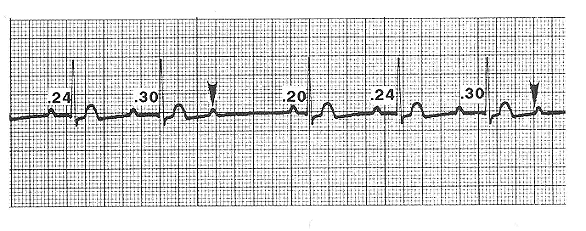There are two different forms of second degree heart block called Mobitz type I (Wenckebach after the person who first described it) and Mobitz type II. In both forms of second degree AV block, the electrical impulse is delayed by the AV node and occasionally, the impulse is blocked completely with the result being the ventricles do not contract, and therefore no blood is pumped through the body. The difference between the two forms of block is that in Mobitz type I, the PR interval progressively lengthens until an impulse is blocked. In Mobitz type II, the PR interval is prolonged but constant with an occasional impulse being blocked. Of the two forms, Mobitz type II is generally considered more serious because it is more likely to progress to high degree or 3rd (complete) degree block which are described below. Patients with second degree block will frequently complain of palpitations or skipped beats or may feel lightheaded or dizzy. They may occasionally experience near syncope or syncope (passing out).
Overview
Normal Rhythms
Atrial Arrhythmias
- Atrial Ectopic Rhythm
- Atrial Fibrillation / Flutter
- Junctional Rhythm
- PACs
- PSVT / PAT / SVT
- Sinus Bradycardia
- Sinus Pauses / Asystole
- Sinus Tachycardia
Conduction Disturbances
Ventricular Arrhymias
Miscellaneous Rhythms
Second Degree AV Block

The above EKG shows an example of Mobitz type I. The distinguishing characteristic is that the PR interval progressively lengthens from .20 to .30 seconds until one of the P waves is not conducted to the ventricles. This causes the heart to in effect, skip or drop a beat. The arrows point to the dropped beats when the P waves were not conducted to the ventricles. Treatment is often not indicated with Mobitz type I.

The above EKG shows an example of Mobitz type II. The distinguishing characteristic is that the PR interval for conducted beats is .18 seconds, but some of the P waves are not conducted to the ventricles. In the above example, the arrows point to the P waves that were not conducted to the ventricles. Treatment is generally indicated with this rhythm and may consist of medications or an implantable pacemaker.
